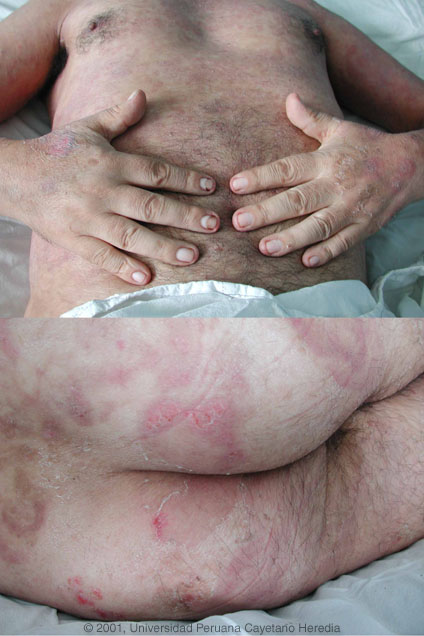2001 Case #5 |
 |
|
2001 Case #5
|
 |
|
| Diagnosis: Pemphigus foliaceus (or endemic pemphigus). Concomitant infection with Fasciola hepatica. |
| Discussion: The endemic form of pemphigus foliaceus is an autoimmune disease, found predominantly in Brazil and neighboring South American countries that is characterized by superficial sub-corneum stratum blisters and by autoantibodies to desmoglein. Epidemiologic features including geographic, temporal, and familial clustering suggest that the production of autoantibodies is linked to exposure to an as yet unidentified environmental antigen.
In this case, the skin biopsy showed characteristic separation at the stratum corneum as well as positive immunostaining for IgG at that level. Several features differentiate pemphigus foliaceus from pemphigus vulgaris. In direct contrast to pemphigus foliaceus, pemphigus vulgaris occurs sporadically, affects adults entirely, familial cases are not seen, skin lesions affect the suprabasilar layer (deeper layer), mucosal lesions are common, and has a guarded prognosis even with therapy. Pemphigus foliaceus affects mostly children and younger adults and while the mortality in the pre-corticosteroid era was around 40%, it responds well in almost all cases to systemic corticosteroids. Clinically, a Nikolsky sign is usually present (positive in our patient). Several generalized forms of the disease occur, and the evolution may be acute, chronic, or relapsing. Bullous lesions may be predominant with a minor component of exfoliative dermatitis or exfoliative erythroderma with scaling and crusting may predominate. Localized forms do occur with a predominance of plaques and nodules. The experience in Peru is that pemphigus foliaceus is reasonably common despite the lack of large case series such as from neighboring Brazil. Up to several cases a month can be seen at the Tropical Medicine Institute in Lima. Patients generally come from rural, farming, or jungle areas. The patient responded well to Further reading: N Engl J Med 2000;343:23-30. J Am Acad Dermatol 1989;20:657-69.
|
